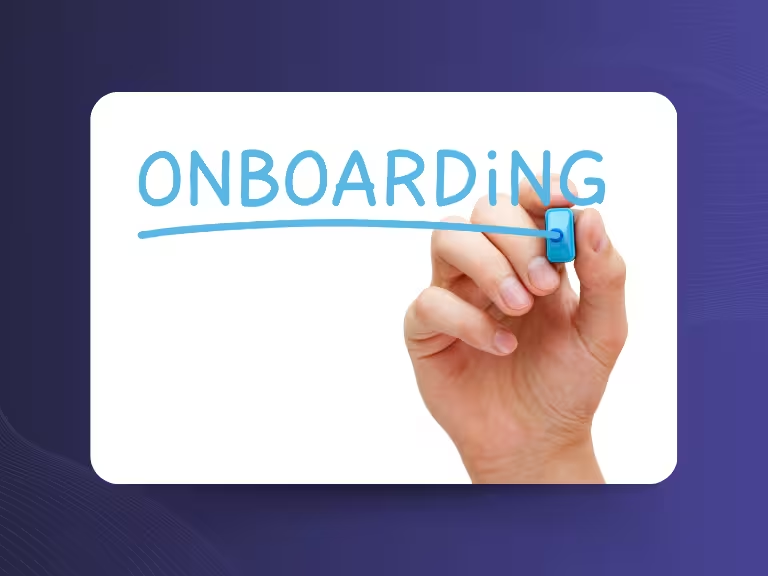Table of Contents
Remote work is no longer an exception but a reality in many companies. This presents HR professionals with a new challenge: How can remote employee onboarding be successful? While new colleagues used to simply come to the office on their first day and quickly find their way around, today's environment requires well-thought-out strategies. Without personal contact and spontaneous office conversations, integration can be delayed – with costly consequences for productivity and employee retention.
In this article, you'll learn proven strategies, helpful tools, and important psychological aspects that make your remote onboarding successful. We'll show you practical solutions that work even in smaller companies.
Challenges in Remote Employee Onboarding
Lack of Personal Contact and Social Interactions
Imagine this: Lisa starts her new job as a marketing manager – not at the office, but from her home desk. No colleagues dropping by casually. No coffee breaks where questions can be clarified informally. These missing spontaneous conversations are often why new remote employees feel isolated.
The problem: While in the office someone would notice if the new colleague is sitting confused in front of the computer, this often goes unnoticed in remote work. Uncertainties pile up, and initial hesitation quickly turns into frustration.
Difficulties in Building Company Culture Remotely
Company culture isn't created through PowerPoint presentations. It shows itself in how colleagues interact with each other, how decisions are made, and what values are truly lived. Conveying all of this without the new person experiencing the team personally is a real challenge.
Transparency and clear communication therefore become even more important. What happens incidentally in the office must be consciously planned and communicated remotely.
Technical and Organizational Problems
First day at the new job and the laptop doesn't work? The access credentials are wrong? In remote work, such IT problems can significantly delay the start. Additionally, there are organizational challenges: If the team is spread across different time zones, even scheduling onboarding meetings becomes a puzzle.
An example: A Berlin startup hires a developer from Barcelona. While the German team starts at 9 AM, her workday begins at 10 AM. Such time differences require flexible onboarding concepts.

Structured Onboarding Process for Remote Employees
Pre-Onboarding – Preparation for the First Day
The best remote onboarding begins before the new person even starts. Well-planned pre-onboarding creates anticipation and reduces nervousness.
Send a welcome package with all important information: access credentials, hardware setup, security guidelines, and maybe even a small company goodie. Ensure all technical requirements are met. Nothing is more frustrating than a first workday that begins with IT problems.
A practical tip: Create a checklist with everything that must be completed before the first day. This way you won't forget anything and the new person knows exactly what to expect.
The First Workday – Clear Agenda and Personal Welcome
The first day often determines the entire impression. Plan a virtual welcome by the team – not just by the direct supervisor. Colleagues should also briefly introduce themselves and explain what areas they work in.
Give a clear overview of the first days and weeks. What's on the onboarding plan? What tasks are waiting? What learning objectives should be achieved? Transparency creates security.
Training Phase – Gradual Integration
The first weeks are crucial. Plan regular check-ins – not just once a week, but much more frequently at the beginning. These conversations help identify problems early and allow the new person to gradually grow into their tasks.
Don't just explain the tasks, but also the connections. Why is this activity important? How does it relate to other areas? Such contextual information helps in understanding overall processes.
Continuous Integration and Development
Onboarding doesn't end after the probationary period. Mentoring and buddy programs create lasting connections in the team. This isn't just about professional support, but also social exchange.
Think long-term: What continuing education opportunities exist? How can new employees develop within the company? Showing these perspectives strengthens retention from the beginning.
Tools and Technologies for Effective Remote Onboarding
Communication Platforms
Video conferences are the heart of remote onboarding. Tools like Zoom, Microsoft Teams, or Google Meet enable personal conversations despite physical distance. Important: Use video whenever possible – the personal impression cannot be replaced by anything.
For daily exchange, chat tools like Slack or Microsoft Teams Chat are suitable. Here, quick questions can be asked without immediately scheduling a meeting.
Project Management and Task Management
Trello, Asana, or Jira help distribute tasks transparently and track progress. For new employees, it's particularly important to see who's working on what and how their own tasks fit into the overall context.
Automated reminders and status updates keep everyone informed without constantly having to ask.
Knowledge Management and Documentation
A central knowledge database is worth its weight in gold. Tools like Confluence or Notion collect all important information in one place. New employees can train themselves independently and always have access to current process descriptions.
Create an FAQ section with the most frequently asked questions. This saves time and gives new colleagues the feeling of being able to work independently.
GDPR-Compliant Meeting and Documentation Tools
Data protection is especially important in remote onboarding. Tools like Sally show how it's done: As a GDPR-compliant meeting assistant, Sally automatically joins onboarding conversations, creates transcripts, and summarizes the most important points. This is particularly helpful for new employees who can focus on the conversation without having to take notes on everything.
Such privacy-friendly tools not only increase efficiency but also employee trust in the company.

Psychological Aspects and Social Integration in Remote Onboarding
Dealing with Isolation and Uncertainties
Remote work can be lonely – especially for new employees. Virtual coffee breaks, online game nights, or digital lunch meetings help build social contacts. These informal formats are often just as important as professional conversations.
Schedule regular one-on-one meetings where you can talk not only about tasks but also about feelings and concerns. Sometimes it just takes a listening ear to clear up uncertainties.
Mentoring and Buddy Programs as Social Bridges
A buddy system works particularly well: Each new person gets an experienced colleague as a contact person. This connection goes beyond pure professional questions and creates trustworthy contacts in the team.
The buddy can also help understand unwritten rules: How does communication in the team really work? Which tools are preferred? Such insider information is invaluable.
Intercultural Sensitivity in Global Teams
When colleagues from different cultural backgrounds work together, special sensitivity is needed. Communication styles differ, as do expectations regarding hierarchy or feedback culture.
Intercultural training helps all participants avoid misunderstandings and interact respectfully with each other. Flexibility in working hours and communication styles shows appreciation for cultural diversity.
Feedback, Control, and Continuous Optimization
Feedback Mechanisms in the Onboarding Process
Feedback is essential for successful remote onboarding. Use various channels: surveys, personal conversations, and anonymous feedback tools. Everyone gives feedback differently – offer various options.
Important: Don't just collect feedback, but also respond to it. Show that new employees' opinions are taken seriously and lead to improvements.
KPIs for Measuring Onboarding Success
Measure your onboarding success with clear metrics: How long does it take until new employees are fully productive? How satisfied are they after 30, 60, and 90 days? How does the turnover rate develop?
This data helps continuously improve the onboarding process. Tools like Sally can support this by automatically evaluating meeting content and recognizing trends in communication.
Transition from Onboarding to Long-term Employee Retention
Good onboarding doesn't end after the probationary period. Plan further development during the training phase: What continuing education makes sense? What career goals does the new person have? How can they develop long-term within the company?
Showing these perspectives strengthens retention and reduces turnover. Investments in employee development pay off in the long term.
Conclusion and Outlook
Remote employee onboarding requires more planning than traditional training processes – but the effort is worth it. Structured procedures, the right tools, and attention to psychological aspects are the keys to success.
Particularly important: Onboarding isn't a one-time process, but the starting point of a long-term relationship. Companies that invest here benefit from higher productivity, more satisfied employees, and lower turnover.
The future belongs to hybrid work models and even smarter tools. Those who now lay the foundation for professional remote onboarding are well-equipped for tomorrow's work world.
Further Resources and Recommendations
For implementing your remote onboarding, you'll find helpful tools and platforms: From communication tools like Slack and Zoom to project management software like Asana to GDPR-compliant meeting assistants like Sally that automatically document your onboarding conversations.
Further studies on remote work and employee retention offer additional insights. Special webinars and training on remote onboarding can also help your team become even more professional.
The key lies in testing different approaches and continuously optimizing. Every company and every team is different – find out what works best for you.

Try meeting transcription now!
Experience how effortless meeting notes can be – try Sally free for 4 weeks.
Test NowOr: Arrange a Demo Appointment

.avif)



